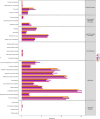Therapeutic effect of fecal microbiota transplantation on rats with liver cirrhosis and its influence on gut microbiota
- PMID: 39055874
- PMCID: PMC11266741
- DOI: 10.22038/IJBMS.2024.74280.16142
Therapeutic effect of fecal microbiota transplantation on rats with liver cirrhosis and its influence on gut microbiota
Abstract
Objectives: This study aimed to explore the therapeutic effect of fecal microbiota transplantation (FMT) on liver cirrhosis-induced rat models by studying changes in intestinal flora distribution and liver pathology.
Materials and methods: Cirrhosis was induced in adult male Sprague-Dawley rats using carbon tetrachloride; successful establishment of the cirrhosis model was verified using hematoxylin and eosin (HE) staining. Rats were divided into normal control, cirrhosis model+normal saline, and cirrhosis model+FMT groups. Fecal intestinal flora was analyzed using 16S rRNA high-throughput sequencing for each group. Alpha diversity, beta diversity, and functional prediction analyses were performed. Additionally, rat liver tissue was subjected to HE staining to compare the degree of fibrosis and liver damage between the groups.
Results: FMT significantly improved the diversity, richness, and uniformity of the intestinal flora in rats with liver cirrhosis. Notably, post-FMT, the abundance of lactobacillaceae, bacilli, and bacteroidia increased, while the abundance of clostridia decreased. Moreover, hepatic fibrosis improved after FMT.
Conclusion: The dysbiosis of intestinal flora in rats with liver cirrhosis improved after FMT. Thus, FMT can regulate intestinal flora, reduce liver inflammation, and improve hepatic fibrosis and cirrhosis.
Keywords: 16S rRNA; Fecal microbiota- transplantation; Gut microbiota; Intestinal flora; Liver cirrhosis.
Conflict of interest statement
No benefits in any form have been received or will be received from a commercial party related directly or indirectly to the subject of this article.
Figures








Similar articles
-
Beneficial effects of LRP6-CRISPR on prevention of alcohol-related liver injury surpassed fecal microbiota transplant in a rat model.Gut Microbes. 2020 Jul 3;11(4):1015-1029. doi: 10.1080/19490976.2020.1736457. Epub 2020 Mar 13. Gut Microbes. 2020. PMID: 32167008 Free PMC article.
-
Fecal microbiota transplantation prevents hepatic encephalopathy in rats with carbon tetrachloride-induced acute hepatic dysfunction.World J Gastroenterol. 2017 Oct 14;23(38):6983-6994. doi: 10.3748/wjg.v23.i38.6983. World J Gastroenterol. 2017. PMID: 29097871 Free PMC article.
-
Effect of artesunate supplementation on bacterial translocation and dysbiosis of gut microbiota in rats with liver cirrhosis.World J Gastroenterol. 2016 Mar 14;22(10):2949-59. doi: 10.3748/wjg.v22.i10.2949. World J Gastroenterol. 2016. PMID: 26973391 Free PMC article.
-
16S rDNA analysis of the effect of fecal microbiota transplantation on pulmonary and intestinal flora.3 Biotech. 2017 Dec;7(6):370. doi: 10.1007/s13205-017-0997-x. Epub 2017 Oct 12. 3 Biotech. 2017. PMID: 29071167 Free PMC article. Review.
-
[Fecal microbiota transplantation in the treatment of acute intestinal pseudo obstruction secondary to intracerebral hemorrhage: a case report and literature review].Zhonghua Wei Zhong Bing Ji Jiu Yi Xue. 2022 Mar;34(3):306-310. doi: 10.3760/cma.j.cn121430-20220225-00179. Zhonghua Wei Zhong Bing Ji Jiu Yi Xue. 2022. PMID: 35574751 Review. Chinese.
Cited by
-
Gut microbiota in liver diseases: initiation, development and therapy.Front Med (Lausanne). 2025 Jun 4;12:1615839. doi: 10.3389/fmed.2025.1615839. eCollection 2025. Front Med (Lausanne). 2025. PMID: 40534699 Free PMC article. Review.
-
Clinical features and risk factors for combined Klebsiella pneumoniae infection in patients with liver cirrhosis.World J Hepatol. 2025 Feb 27;17(2):103648. doi: 10.4254/wjh.v17.i2.103648. World J Hepatol. 2025. PMID: 40027572 Free PMC article.
References
-
- Asrani SK, Devarbhavi H, Eaton J, Kamath PS. Burden of liver diseases in the world. J Hepatol. 2019;70:151–171. - PubMed
-
- Ponziani FR, Zocco MA, Cerrito L, Gasbarrini A, Pompili M. Bacterial translocation in patients with liver cirrhosis: Physiology, clinical consequences, and practical implications. Expert Rev Gastroenterol Hepatol. 2018;12:641–656. - PubMed
LinkOut - more resources
Full Text Sources
